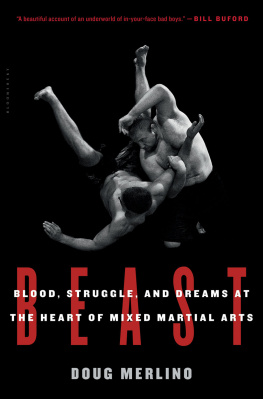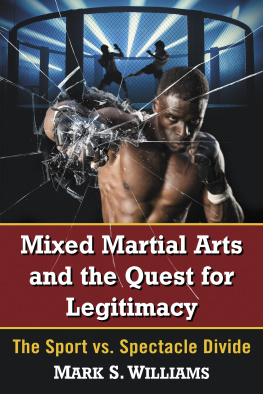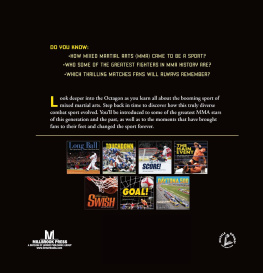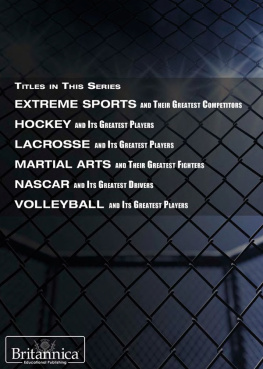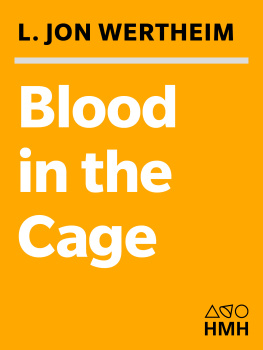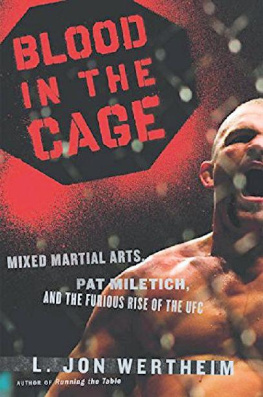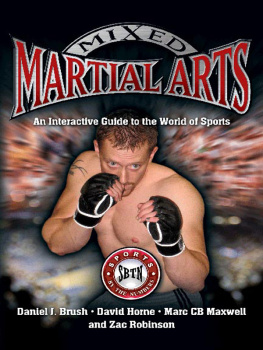For my brothers, Dave and Nik
In memory of James Merlino

As human beings, our greatness lies not so much in being able to remake the worldthat is the myth of the atomic ageas in being able to remake ourselves.
Gandhi
Beast: When referring to a person, beast status is achieved when the aforementioned person is so good at a certain skill that they have exceeded human comprehension, thus making them non-human.
Urban Dictionary
Contents

American Top Team
(Beowulf Sheehan)
One morning in early 2012, I watched from a set of aluminum bleachers as dozens of fighters advanced in rows across a length of gray mats, punching the air in unison, dipping a knee to the ground, rising, and repeating. We were in a warehouse gym in a South Florida industrial park. Sunlight beamed through tall windows that ran along one side of the space. Ceiling fans circulated cooled air. Championship belts, plaques, and banners hung on the walls above the fighters. Coaches walked among the ranks, encouraging, admonishing, making technical adjustments.
I looked around for Jeff Monson. I didnt think that, at five foot nine and two hundred and forty pounds, covered from head to foot in tattoos, he would be difficult to spot. Id flown down from New York City to meet him, and we had made plans to talk after the training session. After an hour of watching the fighters struggle through an increasingly grueling practice and still no sign, I texted him. He called a few minutes later and apologized. He was in Seattle.
My preoccupation with mixed martial arts had started a year earlier, springing from a conversation with my neighbor in New York, who was a fan. As he enthused about his favorite fighters, I became interested. People fighting in cages?
I barely knew anything of the sport. I was in college in 1993 when the Ultimate Fighting Championship, a pay-per-view spectacle pitting fighters from various martial arts against each other in no-holds-barred combat, debuted. It was, at the time, denounced as a new form of barbarism. But in surely the most unlikely story in sports entertainment in the last two decades, the UFC not only stuck around, but became a business with hundreds of millions of dollars in annual revenues, a broadcast deal with Fox television, and the ability on a good night to sell a million pay-per-views at fifty dollars each.
Below the UFC were numerous mixed martial arts (MMA) promotions, from the Viacom-owned Bellator Fighting Championships to fights put on by small-time promoters in armories, community college gyms, and bars. Gyms that taught the sportwhich combined elements of wrestling, boxing, jiu jitsu, and Muay Thai kickboxingpopulated strip malls in every city and town in the country. It seemed like something out of time, a throwback to the bare-knuckle fighting of the 1800s, an anomaly in an era in which kids arent allowed to ride scooters without helmets.
My neighbor took me to an Irish bar in midtown Manhattan to watch a night of UFC fights. The broadcast began with a shot of a shirtless gladiator, lit by torchlight, standing with his head bowed. A bell rang as an operatic chorus sang in Latin. He pulled his breastplate over his head, secured his leather and metal forearm protectors.
There were voiceovers from the nights opponents:
Im going to break you till you quit.
Im going to try to destroy him, take him out as violently as possible.
The gladiator knelt, grabbed a handful of sand, and let it run through his fingers. A door swung open, flooding him with light.
Cue a nu metal riff and a montage of fighters punching opponents in the face, pummeling them on the ground, kicking them in the head.
A shot of the crowd in Las Vegas at the MGM Grand Garden Arena, men holding up beers and shouting, Woo!
The night is finally upon us, an announcer said. Two men who do not dislike each other, they hate each other. And you know what? The best thing to do is to solve it, solve it tonight, solve it right now.
The fighters made their way to the octagonal cage in pairs. There were Englishmen, African Americans, a Mexican American, a Brazilian, a white guy from Jersey. They fought and bled on a mat imprinted with advertisements for motorcycles, beer, and shaving gel. The winners were briefly interviewed after their fights, thanking their teams and sponsors before being shuffled off.
The fight that stayed with me was between two heavyweights, one chiseled, the other with a belly that sagged over his shorts. The muscular fighter dominated the first two rounds, peppering his hapless opponent with punches. In the third and last round, however, the chubby fighter snuck a hook to the chin of his brawny adversary, who collapsed, unconscious. It was shocking, violent, and electrifying.
I left the bar energized. On one level, cage fighting embodied much of what were taught is wrong: It was aggressive, violent, an unrepentant celebration of what some would call regressive masculinity. It was also completely in tune with these anxious timesfighters were presented as warriors battling their demons, overcoming fear, standing up in a world that was increasingly technologized and impersonal. They embodied virtues such as hard work, discipline, courage, and honor. They were freelancers whose product was their own bodies.
Who are these guys? I wondered. How does this whole thing work? I read a few of the dozens of websites dedicated to the sport, which offered minute coverage of its daily dramasthe coming fights and the rivalriesbut little in-depth. Of the books written on mixed martial arts, most were quickie autobiographies by popular fighters, revealing little of substance. The only way to sufficiently answer my questions about the men who chose to fight in this unforgiving sport, I realized, was to get out and ask the fighters themselves.
I started by visiting a fight team in Philadelphia. They practiced on the second floor of a furniture warehouse, a space so dank with body odor that breathing was a chore. They invited me to a local card that included several of their fighters. I sat next to the cage while one fighter had his femur broken in half and another had the orbital bone in his face shattered. None of the fighters from the gym I was with was seriously injured: They went out for beers afterward.
But none of them, I knew, was going any farther than Philadelphia. They trained hard but, with jobs and lives outside the gym, werent at the level of athleticism or commitment to make it into the elite levels. I was curious about the fighters at the top of the sport. To find them, Id have to go to one of the countrys three MMA super camps, gyms that were home to dozens of fighters that filled out the events of the worlds top promotions: American Kickboxing Academy in San Jose; Greg Jackson and Mike Winklejohns gym in Albuquerque; or American Top Team (ATT) in Coconut Creek, Florida, a suburb just south of Boca Raton.
I chose ATT because of Jeff Monson, who was exactly the character someone looking to write about cage fighting would seek out. At forty-one years old, hed been fighting for fifteen years, including a failed shot at the UFC heavyweight championship. He was a former mental health counselor and a self-proclaimed anarchist who had no qualms about sharing his opinions.
When I contacted him, he told me he was planning to come to New York City to take part in the Occupy Wall Street protests. When he failed to make it, I decided to fly to Florida, and so wed arranged to get together at the gym.
Next page
